The labor market has weakened, for everyone, and young college grads aren't really suffering much more than all workers, as indicated by the employment rate chart above. That doesn't mean it's easy, just that the overwhelming focus on young BAs might be a little misplaced.
26.06.2025 14:30 — 👍 3 🔁 0 💬 1 📌 0
While Thompson makes a good argument that AI is changing how people (especially recent college grads) search for jobs, it is not AI that is making the hiring picture so gloomy for recent college grads. It's business uncertainty and a very unusual reference frame.
26.06.2025 14:30 — 👍 2 🔁 0 💬 1 📌 0
Notice a theme? Businesses don't like to hire when there's a lot of uncertainty about what's going to happen. Young people bear the brunt: research.upjohn.org/cgi/viewcont...
26.06.2025 14:30 — 👍 1 🔁 0 💬 1 📌 0
These groups, coming out of school, are especially sensitive to hiring trends, which have a LOT of headwinds right now, from the simple reversion to the mean, to tariff uncertainty, interest rate uncertainty, geopolitical uncertainty, and AI uncertainty.
26.06.2025 14:30 — 👍 1 🔁 0 💬 2 📌 0
However, the labor market in 2021 and 2022 was unprecedently hot for young folks, regardless of education, and this sort of became the benchmark in many minds, especially for college students seeing their peers a few years ahead.
26.06.2025 14:30 — 👍 1 🔁 0 💬 1 📌 0
So what's really going on? The labor market has been weakening for everyone for the past two and a half years. Hiring in particular is way down, www.upjohn.org/sites/defaul..., even if layoffs remain relatively muted.
26.06.2025 14:30 — 👍 2 🔁 0 💬 1 📌 0
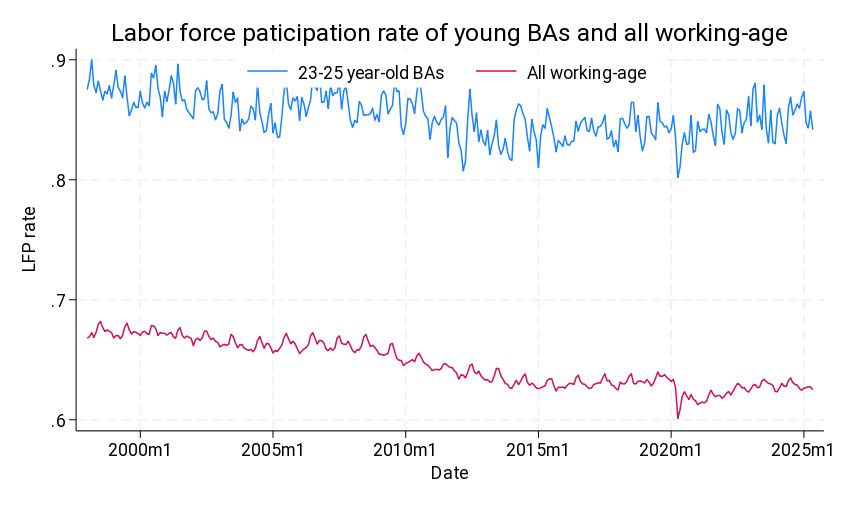
The reason for the different patterns? Changing labor force participation rates. Young college grads are about as likely to be in the labor force as they were at the end of the Greta Recession. All working age folks, not so much, as they have gotten much older on average.
26.06.2025 14:30 — 👍 1 🔁 0 💬 1 📌 0
Now we see that the unemployment rate of young college grads has largely exceeded the unemployment rate of all working-age adults since the end of COVID. Unlike the *employment rate*, the gap today is much larger than in 2018, and this looks bad.
26.06.2025 14:30 — 👍 1 🔁 0 💬 1 📌 0
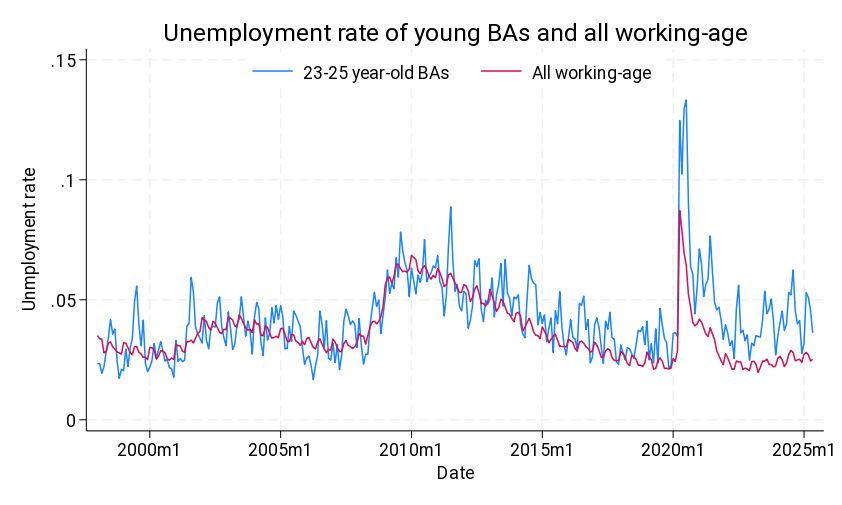
If we look at the *unemployment rate*--the fraction of people without a job and looking for one relative to people either with jobs or unemployed--we get this picture:
26.06.2025 14:30 — 👍 1 🔁 0 💬 1 📌 0
The employment rate of young college grads is certainly lower than it was in the early 2000s, but it's pretty close to where it was in 2018--hardly a bad labor market. Interestingly, the same pattern holds for *all* working-age adults.
26.06.2025 14:30 — 👍 1 🔁 0 💬 1 📌 0
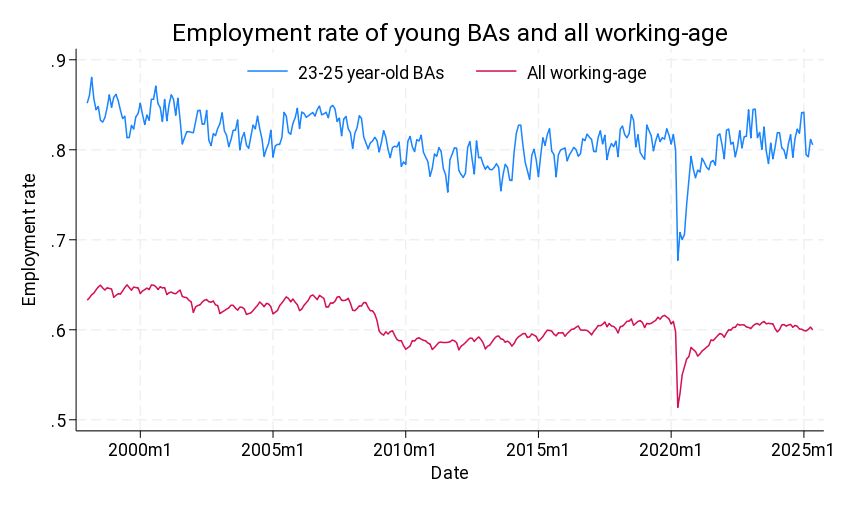
*Employment rates* are the share of people with jobs. Here's the graph for young BAs (age 23-25) and all working-age adults:
26.06.2025 14:30 — 👍 2 🔁 0 💬 1 📌 0
It's technically true, but it's also misleading. Why? Because labor force participation rates have been changing over time, and the unemployment rate doesn't account for this. To see this, let's compare *employment rates* and *unemployment rates*.
26.06.2025 14:30 — 👍 1 🔁 0 💬 1 📌 0
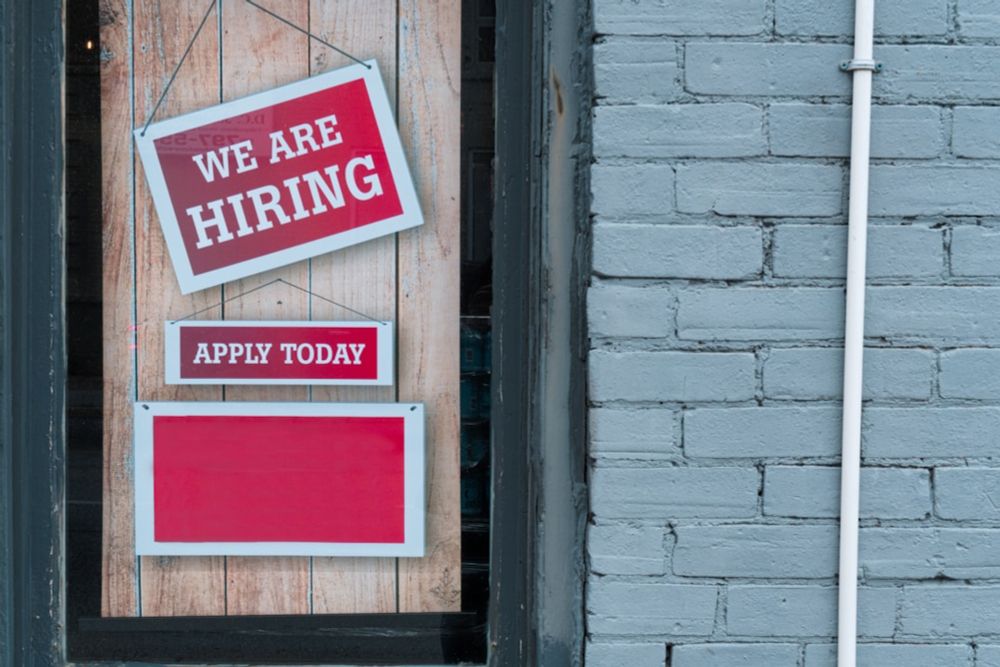
Young People Face a Hiring Crisis. AI Is Making It Worse.
Artificial intelligence is transforming the entire pipeline from college to the workforce: from tests and grades to job applications and entry-level work.
Derek Thompson @dkthomp.bsky.social) has an interesting new Substack blog that echoes the trendy pundit finding that unemployment rates for new college grads are at record highs relative to the overall employment rate. open.substack.com/pub/derektho...
26.06.2025 14:30 — 👍 17 🔁 11 💬 1 📌 1
Thus far in 2025, these patterns have roughly reversed, implying deteriorating opportunities for many less-skilled foreign-born workers, as remaining hires for the group are more concentrated in higher-wage positions. 8/8
04.06.2025 14:17 — 👍 0 🔁 0 💬 1 📌 0
In 2024, the increase in foreign-born hiring, along with a decreasing wage index for this group, suggests that more of these workers were taking jobs in relatively low-paying occupations. 7/8
04.06.2025 14:17 — 👍 0 🔁 0 💬 1 📌 0
Hiring is pretty poor across the board right now, especially relative to the post-COVID boom of a few years ago. Some of this is natural, a return to equilibrium, but some is likely influenced by recent policies. 6/8
04.06.2025 14:17 — 👍 0 🔁 0 💬 1 📌 0
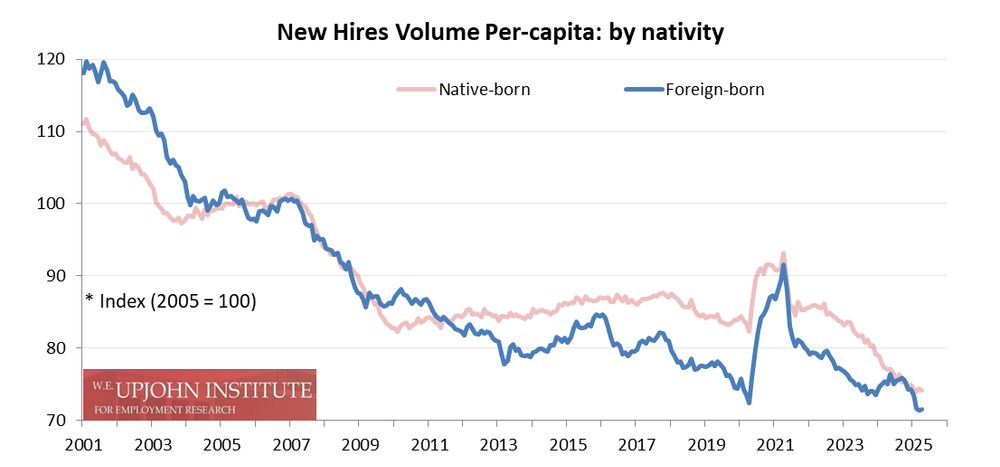
Of course, the number of the foreign-born in the U.S. has also increased, so if we look at *hiring rates* (hires per capita), it turns out that that the likelihood of taking a new job is essentially at record lows for both groups, with an especially sharp decline for the foreign-born recently. 5/8
04.06.2025 14:17 — 👍 0 🔁 0 💬 1 📌 0
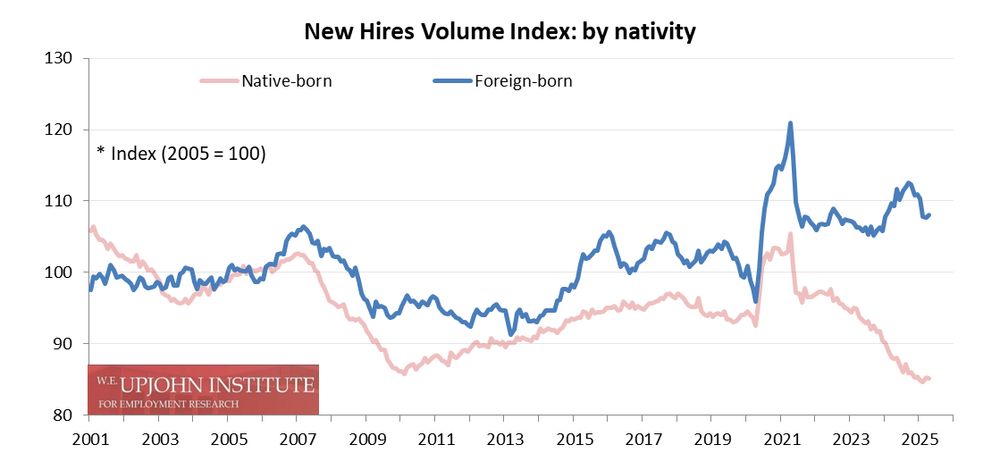
Hiring *volume* is another story: after jumping in 2024, hiring of foreign-born workers has dropped precipitously in the year to date, although hiring of native-born workers has also fallen, continuing a a nearly three-year trend. 4/8
04.06.2025 14:17 — 👍 0 🔁 0 💬 1 📌 0

If anything, there has been a slight uptick over the past few months, even as earnings power for newly-hired native-born workers has stayed flat. 3/8
04.06.2025 14:17 — 👍 0 🔁 0 💬 1 📌 0

But with multiple administration policies making the work climate harder for immigrants, how has hiring changed for foreign-born workers? Their earnings power has fallen sharply, but this has been going on for two years... 2/8
04.06.2025 14:17 — 👍 1 🔁 0 💬 1 📌 0
This month's NHQI, www.upjohn.org/sites/defaul..., shows earnings power of new hires ticked up 0.3 percent even as hiring rates are near record lows, down 8.1 percent from before COVID. 1/8
04.06.2025 14:17 — 👍 1 🔁 1 💬 1 📌 1
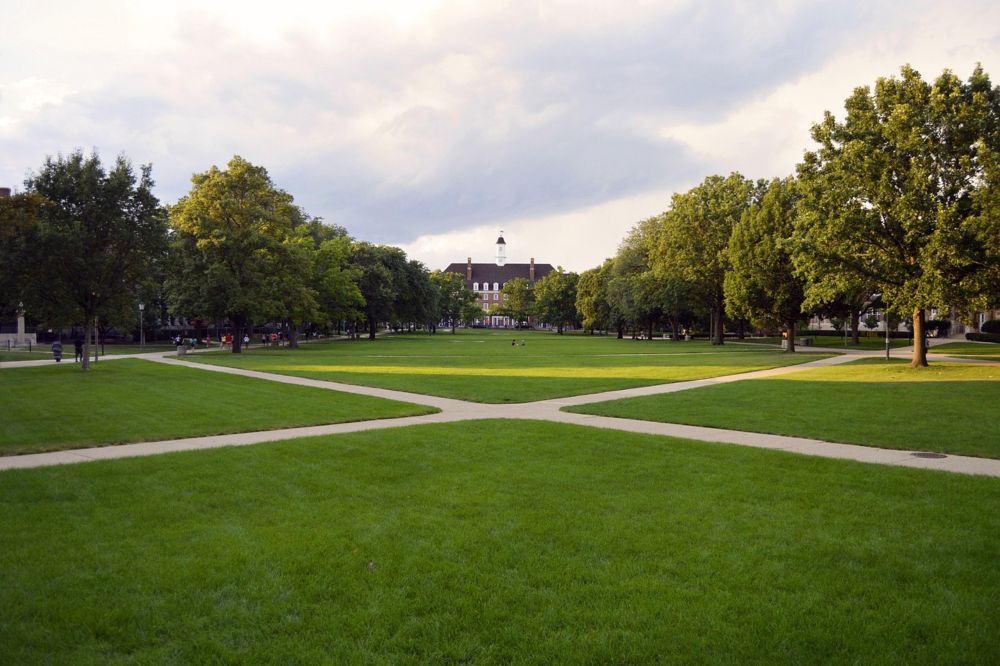
Upjohn Institute announces 2025 Early Career Research Awards
This great group of junior scholars will study topics of critical interest to the Upjohn Institute and all of us. Congratulations to all the winners amidst a very competitive applicant pool! See the list at www.upjohn.org/news/upjohn-...
08.04.2025 17:18 — 👍 2 🔁 1 💬 0 📌 0
With tariffs on Canada and Mexico having taken effect yesterday, with more to come, along with federal spending cuts and layoffs, lingering inflation from high and still rising housing prices, and plummeting consumer confidence, don't expect hiring to pick up any time soon.
05.03.2025 14:49 — 👍 2 🔁 1 💬 0 📌 0
This means that high-earnings jobs in manufacturing, construction, and mining have gotten very scarce, even if somewhat lower-paying jobs are still available. For services, the hiring slowdown has been driven by lower-paying jobs, many in temps.
05.03.2025 14:49 — 👍 1 🔁 0 💬 1 📌 0
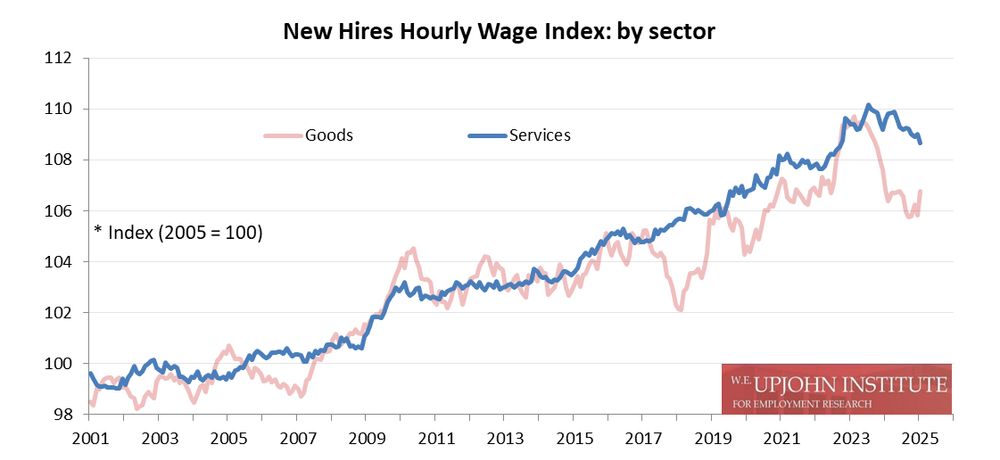
But the earnings power of those jobs in the goods sector has been dropping sharply, much faster than in the services sector:
05.03.2025 14:49 — 👍 1 🔁 0 💬 1 📌 0

The hiring slowdown has been occurring most sharply in the service sector, down 2.7 percent just in the past seven months, even as hiring in the goods sector has ticked up slightly:
05.03.2025 14:49 — 👍 2 🔁 0 💬 1 📌 0
But hiring has really tumbled: down 0.6 percent between December and January, 4.2 percent over the past 12 months, and 5.9 percent since before the pandemic. It is at its lowest level since 2011.
05.03.2025 14:49 — 👍 1 🔁 0 💬 1 📌 0

In January 2025 (www.upjohn.org/sites/defaul...), the earnings index slipped 0.1 percent over the month, continuing a slide begun in late 2023. It is down 0.6 percent over the year, but is still well above its prepandemic level.
05.03.2025 14:49 — 👍 2 🔁 0 💬 1 📌 0
NHQI: New Hires Quality Index | Upjohn Institute
As we appear headed for more economic turmoil, I wanted to share the latest New Hires Quality Index from @upjohninstitute.bsky.social, which tracks the earnings power of newly hired workers: www.upjohn.org/nhqi
05.03.2025 14:49 — 👍 8 🔁 3 💬 2 📌 2










